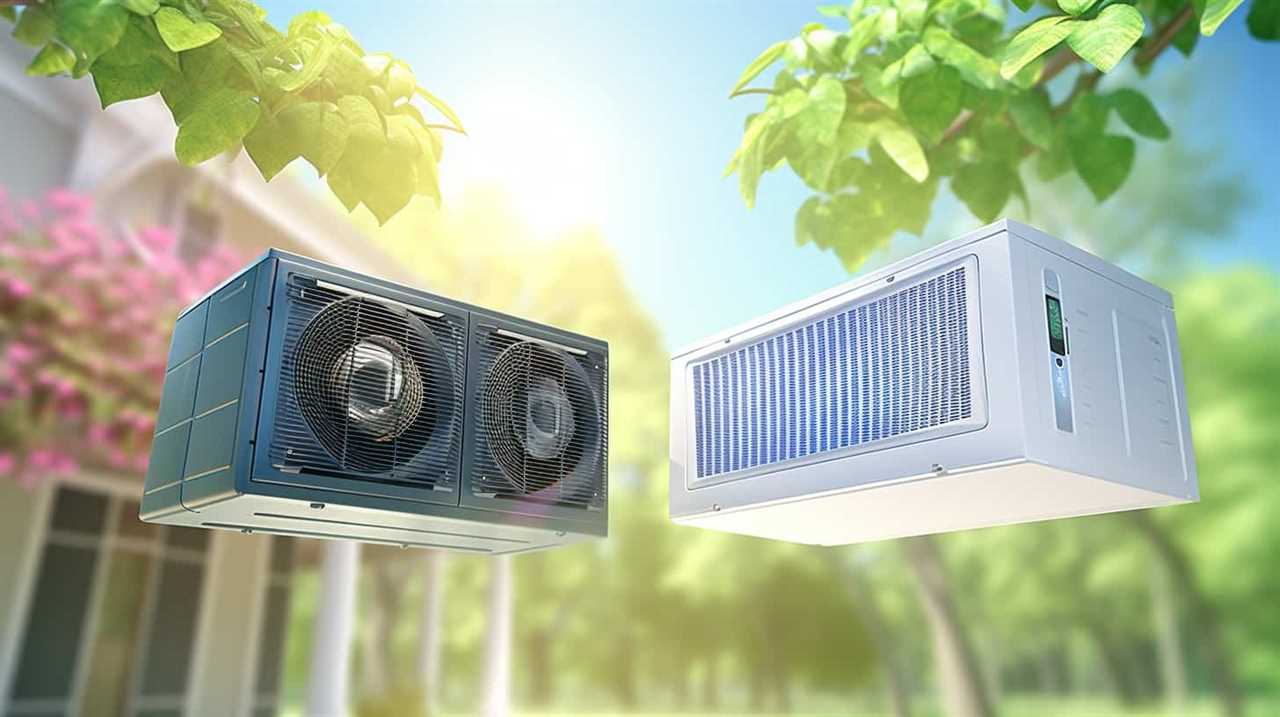Are you interested in learning how the refrigeration cycle of heat pumps affects the environment? If so, we’ve got all the information you need!
In this article, we’ll delve into the basics of the refrigeration cycle, explore its environmental impact, and analyze its efficiency in reducing our carbon footprint.
We’ll also discuss environmental concerns and potential solutions, as well as future innovations that could bring about significant environmental benefits.
So, let’s dive in and discover how heat pumps’ refrigeration cycle can serve our planet better!

Key Takeaways
- Heat pumps produce lower emissions compared to traditional systems.
- Energy-efficient heat pumps consume less electricity, resulting in energy savings.
- The type of refrigerant used can significantly impact the environment.
- Improving the energy efficiency of heat pumps’ refrigeration cycle yields environmental benefits.
The Basics of Heat Pumps’ Refrigeration Cycle
We’ll now explore the fundamentals of the heat pumps’ refrigeration cycle. Understanding efficiency and complying with environmental regulations are crucial when it comes to heat pumps.
Heat pumps work by transferring heat from one place to another, using a refrigerant to facilitate the process. The cycle starts with the refrigerant absorbing heat from the outside air or ground, evaporating into a low-pressure gas.
This gas is then compressed, which increases its temperature and pressure. Next, the hot gas releases heat as it condenses into a high-pressure liquid. The liquid then moves through an expansion valve, decreasing its pressure and temperature, ready to absorb heat again.
This cycle allows heat pumps to provide both heating and cooling, making them highly efficient and environmentally friendly alternatives to traditional heating and cooling systems.

Understanding the Environmental Impact of Heat Pumps’ Refrigeration Cycle
When considering the environmental impact of heat pumps’ refrigeration cycle, two key points come to mind.
First, heat pumps produce lower emissions compared to traditional heating and cooling systems, which is a positive from an environmental standpoint.
Second, heat pumps offer energy efficiency benefits, as they transfer heat rather than generate it, resulting in reduced energy consumption.
These points highlight the potential of heat pumps to mitigate climate change and promote sustainable energy use.

Emissions From Heat Pumps
As we delve into the topic of emissions from heat pumps, it’s important to understand the environmental impact of their refrigeration cycle. Heat pumps are widely regarded as a more environmentally friendly alternative to traditional heating and cooling systems. They operate by transferring heat from one place to another using a refrigerant. However, it’s crucial to consider the emissions associated with the refrigerant and the energy source used to power the heat pump.
To mitigate the environmental impact, emissions reduction strategies can be implemented. These strategies include using low-global warming potential refrigerants and improving the energy efficiency of the heat pump system. Conducting a carbon footprint analysis can also help identify areas for improvement and inform decision-making processes.
Energy Efficiency Benefits?
Improving the energy efficiency of heat pumps’ refrigeration cycle can yield significant environmental benefits. By reducing energy consumption and optimizing performance, heat pumps contribute to energy savings and help mitigate climate change. Here are some key benefits of enhancing the energy efficiency of heat pumps’ refrigeration cycle:
-
Energy savings: Energy-efficient heat pumps consume less electricity, resulting in lower utility bills and reduced demand on power grids.

-
Carbon footprint reduction: By utilizing less energy from fossil fuel-based power plants, energy-efficient heat pumps help decrease greenhouse gas emissions, thereby reducing carbon footprints.
-
Environmental preservation: The reduced energy consumption of energy-efficient heat pumps helps conserve natural resources and minimizes the environmental impact of energy production.
-
Improved air quality: Energy-efficient heat pumps operate more cleanly, reducing the release of pollutants and improving indoor and outdoor air quality.
-
Sustainable future: By embracing energy efficiency in heat pumps, we can contribute to a more sustainable and environmentally friendly future.

Through energy savings and carbon footprint reduction, improving the energy efficiency of heat pumps’ refrigeration cycle plays a vital role in mitigating climate change and preserving the environment.
Key Components of Heat Pumps’ Refrigeration Cycle and Their Impact on the Environment
When considering the key components of heat pumps’ refrigeration cycle and their impact on the environment, it’s important to analyze the environmental consequences of these components and their overall efficiency.
By examining the materials used in the construction of heat pumps and their potential for emissions, we can assess their environmental footprint.
Additionally, evaluating the efficiency of the refrigeration cycle allows us to understand how effectively heat pumps can transfer heat and reduce energy consumption, ultimately contributing to a greener future.

Environmental Impact of Components
We have analyzed the overall impact on the environment of the key components in the refrigeration cycle of heat pumps. Here are some important points to consider:
-
Compressor: The compressor is responsible for the circulation of refrigerant in the system. It requires energy to operate, but advancements in technology have led to more efficient and eco-friendly compressors.
-
Refrigerant: The type of refrigerant used in heat pumps can significantly impact the environment. Some refrigerants have high global warming potential, while others are more environmentally friendly.
-
Heat exchangers: Heat exchangers play a crucial role in transferring heat between the refrigerant and the surrounding environment. Proper waste management and recycling of heat exchangers can help reduce environmental impact.

-
Expansion valve: The expansion valve regulates the flow of refrigerant, allowing it to change from a high-pressure liquid to a low-pressure vapor. Using sustainable materials in the manufacturing of expansion valves can contribute to waste reduction and sustainability measures.
-
Piping and insulation: Proper insulation and efficient piping systems can minimize heat loss and improve overall energy efficiency, reducing the environmental impact of heat pumps.
Efficiency of Refrigeration Cycle
Through the efficient operation of key components in the refrigeration cycle, the environmental impact of heat pumps can be minimized. The efficiency of the refrigeration cycle plays a crucial role in improving the performance of heat pumps while adhering to environmental regulations.
One key component that affects efficiency is the compressor. By using advanced technologies and designs, such as variable speed compressors, heat pumps can achieve higher efficiency and reduce energy consumption.

Another important component is the heat exchanger, which transfers heat between the refrigerant and the surrounding environment. Improving the design and materials of the heat exchanger can enhance the overall efficiency of the refrigeration cycle.
Additionally, the expansion valve and evaporator also contribute to the efficiency of the heat pump system. By optimizing these components and ensuring their proper functioning, heat pumps can achieve higher efficiency and minimize their environmental impact.
Analyzing the Efficiency of Heat Pumps’ Refrigeration Cycle in Reducing Environmental Footprint
The efficiency of the heat pumps’ refrigeration cycle plays a crucial role in reducing the environmental footprint. By analyzing the efficiency of this cycle, we can better understand the impact of heat pump technology on the environment and the effectiveness of environmental regulations. Here are five key points to consider:
-
Energy consumption: Efficient heat pumps consume less energy, reducing the demand for fossil fuels and lowering greenhouse gas emissions.

-
Carbon footprint: Higher efficiency means fewer carbon dioxide emissions, helping to mitigate climate change.
-
Resource conservation: Improved efficiency reduces the need for extracting and processing natural resources, preserving them for future generations.
-
Air quality: Heat pumps produce less pollution compared to traditional heating and cooling systems, improving indoor and outdoor air quality.
-
Cost savings: Higher efficiency leads to lower energy bills, saving consumers money in the long run.

Analyzing the efficiency of heat pumps’ refrigeration cycle is essential for making informed decisions to reduce our environmental impact.
Environmental Concerns and Solutions in Heat Pumps’ Refrigeration Cycle
To address the environmental concerns in heat pumps’ refrigeration cycle and find effective solutions, we must focus on minimizing emissions and maximizing energy efficiency. One key aspect is complying with environmental regulations, which set limits on greenhouse gas emissions and encourage the use of sustainable refrigerants.
By adhering to these regulations, heat pump manufacturers can ensure that their products have a minimal impact on the environment. Additionally, using sustainable refrigerants such as hydrofluorocarbons (HFCs) with low global warming potential can significantly reduce the carbon footprint of heat pumps. This shift towards sustainable refrigerants not only helps mitigate climate change but also promotes the preservation of the ozone layer.
By implementing these solutions, we can create a more sustainable and environmentally friendly refrigeration cycle for heat pumps.

Moving forward, let’s explore the potential environmental benefits of future innovations in heat pumps’ refrigeration cycle.
Future Innovations in Heat Pumps’ Refrigeration Cycle and Their Potential Environmental Benefits
Let’s explore how future innovations in the refrigeration cycle of heat pumps can bring potential environmental benefits.
-
Novel technologies in heat pumps’ refrigeration cycle: Advancements in heat pump technology are continuously being made, resulting in more efficient and environmentally friendly refrigeration cycles. These include improvements in compressor technology, the use of advanced refrigerants, and the integration of smart control systems.
-
Potential applications of heat pumps’ refrigeration cycle in renewable energy systems: Heat pumps can play a crucial role in renewable energy systems by utilizing low-grade heat sources such as air, water, or the ground. This enables them to provide heating and cooling while minimizing the use of fossil fuels and reducing greenhouse gas emissions.

-
Energy efficiency: Future innovations in heat pumps’ refrigeration cycle aim to increase energy efficiency, reducing the overall energy consumption and environmental impact of these systems.
-
Reduced refrigerant leakage: Novel technologies are being developed to minimize refrigerant leakage, which is a significant contributor to global warming potential. By reducing leakage, the environmental impact of heat pumps can be further reduced.
-
Integration with energy storage: Integrating heat pumps’ refrigeration cycle with energy storage systems allows for better management of energy supply and demand, increasing overall system efficiency and reducing environmental impact.
These advancements in the refrigeration cycle of heat pumps hold great promise for a sustainable and environmentally friendly future.

Frequently Asked Questions
Can Heat Pumps’ Refrigeration Cycle Be Used in All Types of Buildings and Climates?
Yes, heat pumps’ refrigeration cycle can be used in all types of buildings and climates. The suitability of the building and compatibility with the climate are important factors to consider when determining the effectiveness and efficiency of heat pumps.
Are There Any Potential Health Risks Associated With the Refrigerants Used in Heat Pumps’ Refrigeration Cycle?
There may be potential health risks associated with the refrigerants used in heat pumps’ refrigeration cycle. It is important to consider the environmental impact of these substances and ensure proper handling and disposal to mitigate any negative effects.
How Do Heat Pumps’ Refrigeration Cycle Compare in Terms of Energy Efficiency to Other Heating and Cooling Systems?
In comparing heat pumps’ refrigeration cycle to other heating and cooling systems, a comparative analysis reveals their superior energy efficiency. This assessment also considers the environmental impact, making heat pumps a sustainable choice.
What Are the Main Challenges in Implementing Heat Pumps’ Refrigeration Cycle on a Large Scale and How Can They Be Overcome?
To overcome scalability challenges in implementing heat pumps’ refrigeration cycle on a large scale, we need to focus on improving heat pump technology. This will ensure that heat pumps are more efficient, cost-effective, and environmentally friendly in the long run.

Are There Any Government Incentives or Rebates Available for Installing Heat Pumps’ Refrigeration Cycle Systems?
There are government incentives and rebates available for installing heat pumps’ refrigeration cycle systems. These policies aim to promote the adoption of this technology by making it more cost-effective for consumers.
Conclusion
In conclusion, the heat pumps’ refrigeration cycle plays a significant role in reducing environmental impact. By utilizing key components and optimizing efficiency, heat pumps have the potential to greatly decrease our carbon footprint.
However, it’s essential to address any environmental concerns and continue to innovate in order to maximize the benefits of this technology. As we look to the future, the potential for advancements in the heat pumps’ refrigeration cycle holds promise for further environmental benefits.









